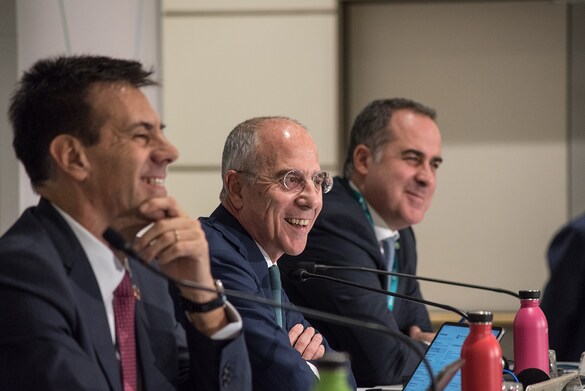Enel Links Investment Plan to SDGs for a Sustainable Future
Since 2015, the United Nations’ Sustainable Development Goals (SDGs) and associated 2030 Agenda for Sustainable Development have set a global framework for improved economic prosperity. The goals are expected to generate at least $12 trillion in market opportunities by 20301.
As corporations increase sustainability practices, the benefits are clear—as are the looming threats. The environmental impact of carbon emissions, and natural resource and ecosystem degradation is costing the world more than $4.5 trillion a year2 and threatening the planet’s future. The need for action is urgent and essential.
Enel Treads a Greener Path
Enel is a prime example. The €70 billion ($78 billion) energy giant is the largest company by market capitalization both in Italy and among European utilities, and in recent years it has actively shifted its business in a greener direction.
In 2015, recognizing the huge challenge facing the energy industry, the company made a strategic decision to move toward renewable energy generation. Francesco Starace, Enel’s CEO, says that as renewable costs have reduced and become more competitive, a “huge battlefield” of opportunity has opened up that the company is actively embracing.
Starace describes how shifting the company’s model to focus on smaller, more flexible renewable energy projects is improving corporate earnings visibility.
Enel increased its capital expenditure from approximately €8 billion ($8.87 billion) in 2015 to around €10 billion ($11 billion) in 2019, around 80% of which was spent on growth initiatives. As a world leader in renewable energy with more than 46 GW of managed capacity across wind, solar, geothermal and hydropower3, Enel is now building its strategy on two pillars: decarbonization and electrification.
Enel has committed to a 70% reduction of its direct greenhouse gas emissions by 2030 compared to 2017 levels, working toward the company’s goal to fully decarbonize its generation mix by 2050. Enel’s commitment to 2030 is consistent with greenhouse gas reductions required to keep global warming to well below 2°C, as certified by the Science Based Targets Initiative.

A Tipping Point for Renewables
Enel’s energy production and capacity reached a tipping point in 2019, Starace explains: “This year was the first time in our portfolio that renewables and thermal power generation were at par. With renewables going up and the others going down, they crossed over in 2019. The value creation through this transition is mind-boggling.”
Enel believes value creation is virtually a given with sustainability and forecasts reliable returns for shareholders in the form of profits, return on invested capital and dividend growth by 2022 and beyond.
An SDG Strategy That Pays Off
The company’s strategy has also evolved in an attempt to reflect the world in which we live. With the SDGs firmly underpinning the activities of 193 countries, 9,000 companies and myriad investors with more than $4 trillion in assets, they are as close to a global standard as the market has seen to date4.
Four of the 17 SDG goals are addressed by around 95% of Enel’s €29 billion ($32 billion) capital expenditure for the next three years:
- Around €14 billion ($15.5 billion) is dedicated to SDG 7—Affordable and Clean Energy—to support the decarbonization process driven by Enel’s Global Power Generation business line and Retail unit.
- Around €12 billion ($13.3 billion) is associated with SDG 9—Industry, Innovation and Infrastructure—to help improve the digitalization and efficiency of Enel’s networks.
- Around €1 billion ($1.1 billion) is associated with SDG 11—Sustainable Cities and Communities—mainly on new electrification services, such as demand response, storage and electric mobility (including the installation of 736,000 public and private charging points across Enel’s network by the end of 2022).
- All these investments will contribute to SDG 13—Climate Action—aimed at taking urgent action against climate change, a core priority for Enel.
While these four global goals are its primary focus, Enel also plans to contribute to the other SDGs through its more sustainable business model, as well as by addressing SDG 17—Partnerships for the Goals—by forging global affiliations to tackle the world’s multiple sustainability challenges. Through its blend of sustainable business and sustainable finance, Enel is forecasting earnings growth of 27% over the next three years.
The company is bullish with regard to its financing. As the Enel Group evolves its debt strategy toward issuance of SDG-linked bonds, it believes this will not only continue to reduce its cost of debt and improve its credit position, but also ensure greater accountability. According to Enel, it is, on average, 15 basis points or 0.15% cheaper to service its SDG-linked bonds than its traditional bonds. Alberto De Paoli, the company CFO, stated that “the continuous improvement of the company’s risk profile, due to the total integration of sustainability into the Group strategy, must be fully recognized by rating agencies, and this would support further room of cost reduction for sustainable finance."
Enel’s SDG-linked bonds—issued in September and October 2019—will pay out a higher rate of interest if the company reneges on meeting certain key performance indicators linked to the SDGs.
By putting its money where its mouth is, Enel is truly holding itself to account.
Written by Sam Shaw for Bloomberg Media Studios.
Sources
1. report.businesscommission.org/report
2. businesscommission.org/our-work/making-the-business-case-for-sustainable-development
3. Enel Capital Markets Day Strategic Plan 2020–22
4. www.edie.net/news/7/Report--SDG-alignment-has-generated--233bn-in-business-revenue-last-year
